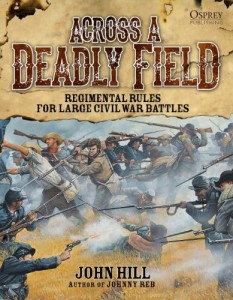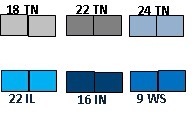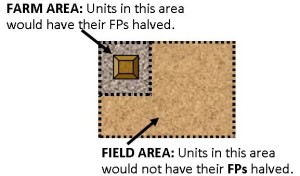“Ask John Hill” will be a new regular column on CigarBoxBattle and will serve as a successor to the same type column found in “The Zouave” and Scott Mingus’ excellent “Charge!” newsletter. If you have rules questions about “Across A Deadly Field” that you would like us to ask the author John Hill, please email us and we will forward to him for possible inclusion in our “Ask John Hill” blog posts. Send questions to – Cory@cigarboxbattle.com (Editor’s note: We are sorry to say that John Hill passed away in 2015. If you have any questions please either forward them to us (and we will send to John’s daughter Stephanie to be answered on her great website), or contact Stephanie Hill directly at – http://acrossadeadlyfield.com . She will be answering questions and posting answers in conjunction with ADF expert P.J. O’Neil. ADF is a great game and we want to continue to support it! – Cory Ring)

ADF Questions And Clarifications
RE: Interpenetration by Skirmishers
1. If a skirmish line if interpenetrated (page 28) by a formed unit does both the formed unit and the skirmishers have to pass a Tactical Competence Test (TCT) to avoid going into disorder?
No, the interpenetration rule on page 28 is intended to apply to two formed non-skirmishing units passing through each other. Interpenetration by or with skirmishers would not require the involved units to pass a TCT.
RE: Farm Areas
1. If a unit fires from within a “farm area” it’s FPs are halved; but, does this also apply if the unit is firing from just on the edge, perhaps from behind a fence?
That would depend on how the large or small farm area is. If it is small, with barely enough room for a few regiments then yes, the clutter of farm buildings would cause deployment difficulties and the FPs would be halved. However, if it is modeled as a large fenced field then units along the fence would not be halved. See example below.
RE: Combined Fire
1. Does a unit have to be in good order to combine their FPs with another unit?
Yes it can; but, remember a disordered unit has its FPs halved, though its figures would still count against the 16 figure maximum per fire. However, a shaken unit cannot since it would be firing at both halved FPs and one less die. But, two adjacent units could not combine fire if they were at different ranges, as they would be rolling a different number of dice. Hence, a useful guideline could be that units can only combine fire when all the units would be rolling the same number of dice.
2. Can a unit combine fire with another adjacent friendly unitagainst an enemy unit, if a different enemy unit is in its primary zone?
No, the requirement that a unit must first engage an enemy unit in its primary zone always takes priority over the ability to combine fire with an adjacent friendly unit. That said, should parts of two enemy units be in a unit’s primary zone, it could choose which one to fireat, or combine fires against. In any case, a unit can never fire or combine fire against a target outside its 45 degree fire arc. See example below.

The Union player might wish to combine the fire of the 22nd IL, the 16th IN and the 9th WS against the 22nd TN since the 22nd TN is indeed within the 45 degree fire arc of each of those Union units. But, that would not be allowed since both the 22nd IL and the 9th WS have targets in their primary zone, which always takes precedence.
3. If, as its first action, a unit moves adjacent to a friendly unit, may it do a combined fire – as a second action – with the friendly unit it just moved adjacent to?
No, because a combined fire is considered to be a form of “group action” and hence is governed by the group action rules, in that all the involved units must be doing the same thing for both actionsand that those actions must be declared before their implementation.
4. Can a second action fire of one unit be combined with the first action fire of a different unit, if both units are adjacent?
No, the first actions of one unit can never be combined with the second actions of a different unit. One unit or unit group must complete both of its two actions before another unit or unit group begins its first action.
Re: Charges
1. If a first action infantry charge ends in a Melee, do the active infantry units lose their 2nd action?
Yes, because for all practical purposes the melee is the unit’s second action.
RE: Leaders and Morale
1. If a leader is adjacent or attached, how many different units can he give morale benefits to?
The benefit differences between attached and adjacent will be clarified and expanded in the optional rules of the Eastern Scenarios book due out this fall. That said, a leader can give a morale benefit to up to four units that he is adjacent to, assuggested by the illustration on page 97 of the ADF rule book and, of course, to any unit he is actually attached to.
2. In ADF, can a unit charge a unit it cannot see?
In both JR III and ADF a unit cannot charge a unit it cannot legally see. However, ADF does give you three tactical options around this. For example, an active unit could move up in its first action in a manner that would give it visibility and then charge in its second action. Secondly, per the “reaction rule” a unit can react to any enemy unit within two inches of it (about 160 – 200 yards), therefore it is logical to assume that an “active unit” could charge any enemy unit within two inches, even if it did not have a legal line-of-sight. Finally, if a leader can see an enemy unit, he can order a friendly unit within his Leader Reaction Radius to make the charge, even if that friendly unit cannot see the intended charge target.
RE: Line of Sight
5. Can a unit see through an orchard?
A unit outside of an orchard can certainly see a unit in an orchard up to one or two inches into the orchard. But, a unit could not seecompletely through an orchard to another unit outside of the orchard. A useful guideline to most terrain related LOS questions can be found on page 108 of the ADF Rulebook.
RE: Cavalry
1. In the “impact resolution” dice down, a unit counts all of its figures for its “unit impact value”. Would this also be true for cavalry which uses a 1:30 figure ratio rather than the infantry’s 1:60 figure ratio?
Due to the different figure ratios, the “unit impact value” for cavalry should be calculated at “1 per 2 figures”. Hence an 8 figure infantry unit would have a “unit impact value” of 8, while an 8 figure cavalry unit would have a “unit impact value” of 4. However, the “charge morale modifier” for cavalry is not affected by the different figure ratio and remains different if the cavalry are mounted or dismounted. For example, a dismounted cavalry line still has a “+1” detriment to its morale for impact and a mounted cavalry line would have a “-1” benefit to its morale for impact.
2. If I prefer to model my cavalry units in a 1:60 figure ratio, what changes are needed to play the game?
The changes are minimal. For the firepower numbers, still use the cavalry FP values; but, for Fire Combat Resolution use the infantry fire row, on the Fire Combat Results Table, as that row is calibrated for a 1:60 figure ratio. Likewise, if using a 1:60 figure ratio, on Impact Resolution, the cavalry unit could count all its figures in the same manner that an infantry unit would.
RE: ADF/JR III
1. I prefer the look of the four stand regiments of Johnny Reb III (JR III) and its 1:30 figure ratio; but, I would like to try using the game mechanics of ADF for its wider range of tactical options. For 15mm figures what changes do I have to make?
The changes would be minimal. Assuming you will be using the JR III ground scale of one inch equals 50 yards with the ADF time scale of half hour turns – you can still use almost all the distances as noted on the ADF 15mm Reference Chart. For instance, in 15mm/JR III, where one inch equals 50 yards, the normal rifle-musket range is 4 inches or 200 yards. If using the 15mm/ADF charts – and assuming one inch still equals 50 yards — normal rifle-musket range is 3 inches or 150 yards, which is close enough. In 15mm/JR III, a battle line in the open can move 6 inches (300 yards) in twenty minutes with reduced fire – while in 15mm/ADF, with two actions, a battle line in the open can move 12 inches (600 yards) in thirty minutes without firing or 6 inches (300 yards) with one firing action. Once again, depending how you factor in the time for decision making and orders being passed down, either “yardstick” works well enough.
For Fire Results – use either the ADF chart as printed (though, that will result in some very bloody fires) or while still using the appropriate ADF/Firepower Points (FP) for infantry or cavalry roll all the fire combat results on the Cavalry Fire Row, as that “results row” has been calibrated for the 1:30 figure ratio. For artillery, the FPs would still be close enough as would the ranges and movement distances. For morale, you would have to use the BMP chart for four stand units, which will be included in the Eastern Scenario book and is already available as a download from CigarBoxBattles website.
RE: Leaders, Adjacent & Attached
1. What are the benefit differences between an adjacent leader and an attached leader?
The key sentence is on page 56…the, “last sentence”: A leader that is adjacent, but not attached can only provide a morale benefit.Hence, for a regiment or a contiguous group of regiments of the same brigade to get the leader’s movement bonus that leader would have to be attached to one of the contiguous regiments of the brigade for the entire turn. However, those regiments would get the movement bonus for both actions, provided they stayed contiguously together.
That would, in my view, strongly indicate that to get any of the other leader benefits, the leader must be attached to a regiment and from then on, the issue would only be what benefits apply to only the regiment he is attached to or for a whole brigade of contiguous units.

